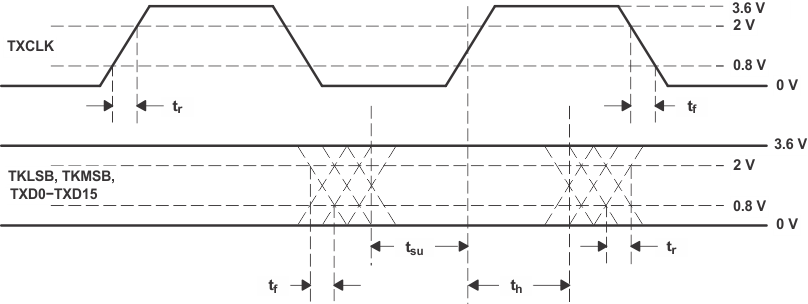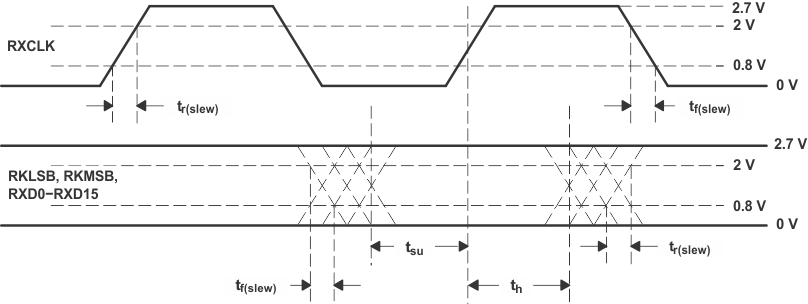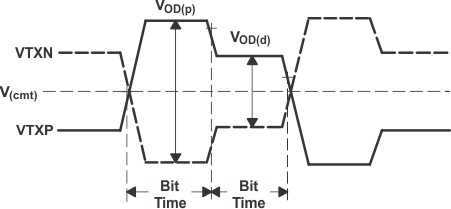SGLS307P July 2006 – February 2018 TLK2711-SP
PRODUCTION DATA.
- 1 Features
- 2 Applications
- 3 Description
- 4 Revision History
- 5 Description (continued)
- 6 Pin Configuration and Functions
-
7 Specifications
- 7.1 Absolute Maximum Ratings
- 7.2 ESD Ratings
- 7.3 Recommended Operating Conditions
- 7.4 Thermal Information
- 7.5 TTL Input Electrical Characteristics
- 7.6 Transmitter/Receiver Electrical Characteristics
- 7.7 Reference Clock (TXCLK) Timing Requirements
- 7.8 TTL Output Switching Characteristics
- 7.9 Typical Characteristics
-
8 Detailed Description
- 8.1 Overview
- 8.2 Functional Block Diagram
- 8.3
Feature Description
- 8.3.1 Transmit Interface
- 8.3.2 Transmit Data Bus
- 8.3.3 Data Transmission Latency
- 8.3.4 8-Bit/10-Bit Encoder
- 8.3.5 Pseudo-Random Bit Stream (PRBS) Generator
- 8.3.6 Parallel to Serial
- 8.3.7 High-Speed Data Output
- 8.3.8 Receive Interface
- 8.3.9 Receive Data Bus
- 8.3.10 Data Reception Latency
- 8.3.11 Serial to Parallel
- 8.3.12 Comma Detect and 8-Bit/10-Bit Decoding
- 8.3.13 LOS Detection
- 8.3.14 PRBS Verification
- 8.3.15 Reference Clock Input
- 8.3.16 Operating Frequency Range
- 8.3.17 Testability
- 8.3.18 Loopback Testing
- 8.3.19 BIST
- 8.3.20 Power-On Reset
- 8.4 Device Functional Modes
- 9 Application and Implementation
- 10Power Supply Recommendations
- 11Layout
- 12Device and Documentation Support
- 13Mechanical, Packaging, and Orderable Information
Package Options
Mechanical Data (Package|Pins)
- HFG|68
Thermal pad, mechanical data (Package|Pins)
Orderable Information
7.8 TTL Output Switching Characteristics
over recommended operating conditions (unless otherwise noted)| PARAMETER | TEST CONDITIONS | MIN | TYP | MAX | UNIT | |
|---|---|---|---|---|---|---|
| VOH | High-level output voltage | IOH = –2 mA, VDD = MIN | 2.1 | 2.3 | V | |
| VOL | Low-level output voltage | IOL = 2 mA, VDD = MIN | 0.25 | 0.5 | V | |
| tr(slew) | Slew rate (rising), magnitude of RXCLK, RKLSB, RKMSB, RXD0 to RXD15 | 0.8 V to 2 V, C = 5 pF, see Figure 2 | 0.5 | V/ns | ||
| tf(slew) | Slew rate (falling), magnitude of RXCLK, RKLSB, RKMSB, RXD0 to RXD15 | 0.8 V to 2 V, C = 5 pF, see Figure 2 | 0.5 | V/ns | ||
| tsu | RXD0 to RXD15, RKMSB, RKLSB setup to ↑ RXCLK | 50% voltage swing, TXCLK = 80 MHz, see Figure 2(1) |
3 | ns | ||
| 50% voltage swing, TXCLK = 125 MHz, see Figure 2(1) |
2.5 | |||||
| th | RXD0 to RXD15, RKMSB, RKLSB hold to ↑ RXCLK | 50% voltage swing, TXCLK = 80 MHz, see Figure 2(1) |
3 | ns | ||
| 50% voltage swing, TXCLK = 125 MHz, see Figure 2(1) |
2 | |||||
(1) Nonproduction tested parameters.
 Figure 1. TTL Data Input Valid Levels for AC Measurements
Figure 1. TTL Data Input Valid Levels for AC Measurements Figure 2. TTL Data Output Valid Levels for AC Measurements
Figure 2. TTL Data Output Valid Levels for AC Measurements Figure 3. Differential and Common-Mode Output Voltage
Figure 3. Differential and Common-Mode Output Voltage Figure 4. Common-Mode Output Voltage Definitions
Figure 4. Common-Mode Output Voltage Definitions